Blazor WebAssembly&JWT鉴权授权
目录
前后端分离下,后端专注于业务逻辑,前端专注于页面交互,Blazor WebAssembly令后端开发者降低学习成本,也能够玩转一些前端开发功能。本文仅简单介绍前后端交互,借助于Blazor WebAssembly如何调用接口,鉴权授权。
新建项目
前端项目为Blazor WebAssembly(Standalone)模板,后端为WebApi。
 本文使用DotNet CLI快速搭建。
本文使用DotNet CLI快速搭建。
dotnet new blazorwasm -n AppDemo -f net9.0
dotnet new webapi -n ApiDemo -f net9.0 -controllers
dotnet new sln
dotnet sln add .\AppDemo\
dotnet sln add .\ApiDemo\
服务端令牌接口
安装Nuget包
dotnet add package Microsoft.AspNetCore.Authentication.JwtBearer
本次不使用数据库验证,直接模拟返回一个JWT。
[ApiController]
[Route("api/[controller]")]
public class AccountController : ControllerBase
{
private const string SecretKey = "YourSuperSecretKeyThatIsAtLeast32CharactersLong!";
private const string Issuer = "ApiDemo";
private const string Audience = "ApiDemo";
private const int ExpirationMinutes = 60;
[Authorize]
[HttpGet("CurrentUserName")]
public string GetCurrentUserName()
{
return "admin";
}
[HttpPost("Login")]
public IActionResult Login([FromBody] LoginRequest request)
{
// 示例:简单的硬编码验证(实际项目中应该从数据库验证)
if (request.Username == "admin" && request.Password == "admin123")
{
var token = GenerateJwtToken(request.Username);
var expires = DateTime.UtcNow.AddMinutes(ExpirationMinutes);
return Ok(new LoginResponse
{
Token = token,
Expires = expires
});
}
return Unauthorized(new { message = "用户名或密码错误" });
}
private string GenerateJwtToken(string username)
{
var key = new SymmetricSecurityKey(Encoding.UTF8.GetBytes(SecretKey));
var credentials = new SigningCredentials(key, SecurityAlgorithms.HmacSha256);
var claims = new[]
{
new Claim(ClaimTypes.Name, username),
new Claim(ClaimTypes.NameIdentifier, username),
new Claim(JwtRegisteredClaimNames.Sub, username),
new Claim(JwtRegisteredClaimNames.Jti, Guid.NewGuid().ToString())
};
var token = new JwtSecurityToken(
issuer: Issuer,
audience: Audience,
claims: claims,
expires: DateTime.UtcNow.AddMinutes(ExpirationMinutes),
signingCredentials: credentials
);
return new JwtSecurityTokenHandler().WriteToken(token);
}
}
public class LoginRequest
{
[Required(ErrorMessage = "用户名不能为空")]
public required string Username { get; set; }
[Required(ErrorMessage = "密码不能为空")]
public required string Password { get; set; }
}
public class LoginResponse
{
public string Token { get; set; } = string.Empty;
public DateTime Expires { get; set; }
}
服务端鉴权配置
简单使用明文方式配置鉴权服务。设定默认Schema为Jwt格式。
using System.Text;
using Microsoft.AspNetCore.Authentication.JwtBearer;
using Microsoft.IdentityModel.Tokens;
const string secretKey = "YourSuperSecretKeyThatIsAtLeast32CharactersLong!";
const string issuer = "ApiDemo";
const string audience = "ApiDemo";
var builder = WebApplication.CreateBuilder(args);
builder.Services.AddControllers();
builder.Services.AddOpenApi();
builder.Services.AddCors(options =>
{
options.AddDefaultPolicy(policy =>
{
policy.AllowAnyOrigin().AllowAnyHeader().AllowAnyMethod();
});
});
builder.Services.AddAuthentication(options =>
{
options.DefaultAuthenticateScheme = JwtBearerDefaults.AuthenticationScheme;
options.DefaultChallengeScheme = JwtBearerDefaults.AuthenticationScheme;
})
.AddJwtBearer(options =>
{
options.TokenValidationParameters = new TokenValidationParameters
{
ValidateIssuer = true,
ValidateAudience = true,
ValidateLifetime = true,
ValidateIssuerSigningKey = true,
ValidIssuer = issuer,
ValidAudience = audience,
IssuerSigningKey = new SymmetricSecurityKey(Encoding.UTF8.GetBytes(secretKey))
};
});
builder.Services.AddAuthorization();
var app = builder.Build();
if (app.Environment.IsDevelopment())
{
app.MapOpenApi();
}
app.UseCors();
app.UseHttpsRedirection();
app.UseAuthentication();
app.UseAuthorization();
app.MapControllers();
app.Run();
服务端设置完毕,仅当用户名密码正确下返回JWT。
客户端请求令牌
Blazor WebAssembly项目中,分开Http的实现通常是个好的做法,新建一个HttpService,并实现请求后端令牌地址。
public class HttpService
{
private readonly HttpClient _httpClient;
public HttpService(HttpClient httpClient)
{
_httpClient = httpClient;
}
public async Task<LoginResponse?> LoginAsync(LoginRequest loginRequest)
{
var response = await _httpClient.PostAsJsonAsync("api/account/login", loginRequest);
if (response.IsSuccessStatusCode)
{
var loginResponse = await response.Content.ReadFromJsonAsync<LoginResponse>();
return loginResponse!;
}
return null;
}
}
public class LoginRequest
{
public required string Username { get; set; }
public required string Password { get; set; }
}
public class LoginResponse
{
public string Token { get; set; } = string.Empty;
public DateTime Expires { get; set; }
}
将其注册到服务容器中
builder.Services.AddScoped<HttpService>();
实现一个简单登录页,调用后端拿到Token。
@page "/login"
@layout EmptyLayout
@using AppDemo.Infrastructures
@inject HttpService _httpService
@inject NavigationManager _navigationManager
<PageTitle>Login</PageTitle>
<div style="display: flex; flex-direction: column; align-items: center; justify-content: center; min-height: 300px;">
<h1>AppDemo</h1>
<input type="text" @bind="username" class="form-control mb-2" style="max-width: 300px;" placeholder="Username" />
<input type="password" @bind="password" class="form-control mb-2" style="max-width: 300px;" placeholder="Password" />
<button @onclick="LoginAsync" class="btn btn-primary" style="width: 300px;">Login</button>
</div>
@code{
private string username = string.Empty;
private string password = string.Empty;
private async Task LoginAsync()
{
var loginRequest = new LoginRequest { Username = username, Password = password };
var loginResponse = await _httpService.LoginAsync(loginRequest);
if (loginResponse != null)
{
_navigationManager.NavigateTo("/");
}
else
{
Console.WriteLine("Login failed");
}
}
}
如此,登录完成后跳转到首页,可是首页要获取用户信息没有token怎么请求,token该存储在哪里。即身份状态需要共享到其他组件中,以支持其他组件需求。
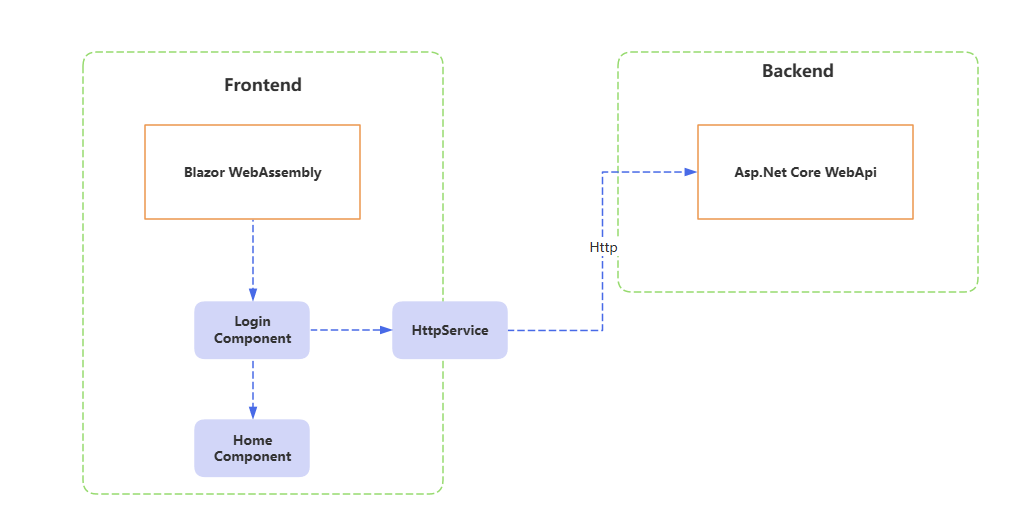
客户端身份状态共享
在纯前端项目中,跨组件共享状态是普遍的。特别是身份验证状态,需要所有组件都可共享。在Blazor WebAssembly中,抽象好了一个AuthenticationStateProvider类来共享身份信息。包括获取身份信息。身份信息变更回调。为此实现一个自定义的StateProvider,在这其中管理JWT。
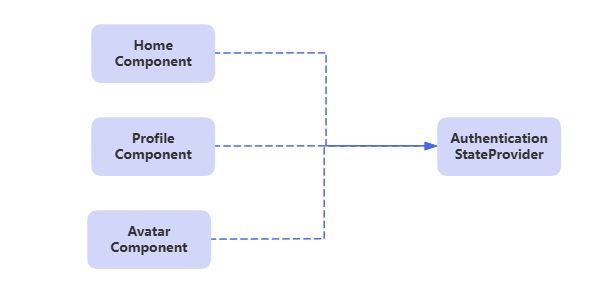 需要增加一个Nuget包
需要增加一个Nuget包
dotnet add package Microsoft.AspNetCore.Components.Authorization --version 9.0.10
自定义身份状态管理类,其身份状态先随便弄一个。
public class CustomAuthStateProvider : AuthenticationStateProvider
{
public override async Task<AuthenticationState> GetAuthenticationStateAsync()
{
var claims = new List<Claim>
{
new Claim(ClaimTypes.Name, "defaultUser")
};
var identity = new ClaimsIdentity(claims, "CustomAuth");
var user = new ClaimsPrincipal(identity);
return new AuthenticationState(user);
}
}
注册鉴权服务、级联身份验证状态服务和自定义身份状态管理类
builder.Services.AddAuthorizationCore();
builder.Services.AddCascadingAuthenticationState();
builder.Services.AddScoped<AuthenticationStateProvider, CustomAuthStateProvider>();
在首页中,获取当前用户信息。
<AuthorizeView>
<Authorized>
<p>Hello, @context.User.Identity?.Name! Welcome to your new app.</p>
</Authorized>
<NotAuthorized>
<p>You're not authorized.</p>
</NotAuthorized>
</AuthorizeView>
此时,仅仅是展示GetAuthenticationStateAsync中的默认值。为此改造一番,在登录完成后,获取到用户信息替换默认值。
客户端请求身份信息
为了令获取到的信息是当前登录人的信息,请求服务端Api,而请求过程需要已得到的Token,因此在登录完成后,需要将Token保存到HttpClient中,以便于在GetAuthenticationStateAsync中请求服务端Api时,能够正常请求。
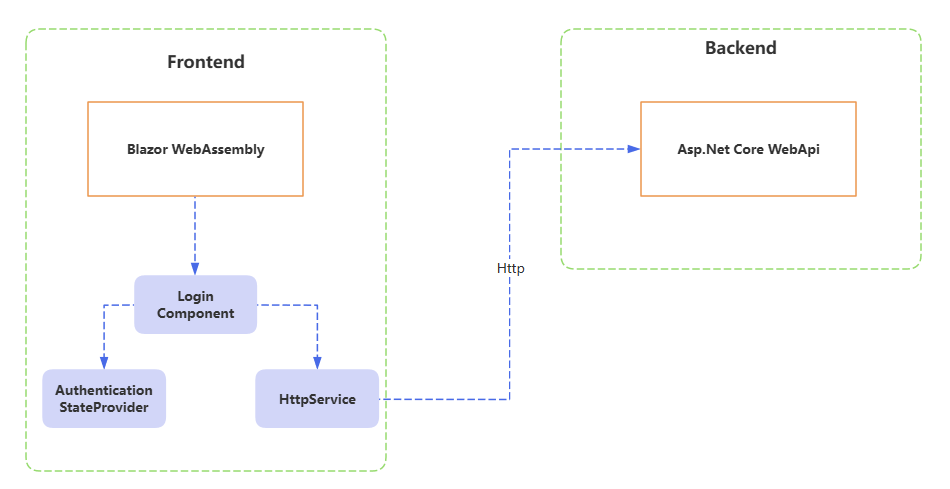 在登录完成后,保存Token到HttpClient头中,以能够在下一次请求时正常。
在登录完成后,保存Token到HttpClient头中,以能够在下一次请求时正常。
public async Task<LoginResponse?> LoginAsync(LoginRequest loginRequest)
{
var response = await _httpClient.PostAsJsonAsync("api/account/login", loginRequest);
if (response.IsSuccessStatusCode)
{
var loginResponse = await response.Content.ReadFromJsonAsync<LoginResponse>();
// 保存到请求头中
_httpClient.DefaultRequestHeaders.Authorization = new AuthenticationHeaderValue("Bearer", loginResponse.Token);
return loginResponse!;
}
return null;
}
并同步StateProvider获取用户信息,以及令身份状态更新
var loginRequest = new LoginRequest { Username = username, Password = password };
var loginResponse = await _httpService.LoginAsync(loginRequest);
if (loginResponse != null)
{
await ((CustomAuthStateProvider)_authStateProvider).MarkUserAsAuthenticated();
_navigationManager.NavigateTo("/");
}
在StateProvider中,先获取最新用户信息,在刷新身份状态,当GetAuthenticationStateAsync中请求服务端Api时,默认携带了请求头,因此不会出现401错误。
public class CustomAuthStateProvider : AuthenticationStateProvider
{
private readonly HttpService _httpService;
public CustomAuthStateProvider(HttpService httpService)
{
_httpService = httpService;
}
public override async Task<AuthenticationState> GetAuthenticationStateAsync()
{
var user = new ClaimsPrincipal(new ClaimsIdentity());
try
{
var currentUserName = await _httpService.GetCurrentUserName();
var claims = new List<Claim>
{
new Claim(ClaimTypes.Name, currentUserName)
};
var identity = new ClaimsIdentity(claims, "CustomAuth");
user = new ClaimsPrincipal(identity);
}
catch (Exception ex)
{
Console.WriteLine(ex.Message);
}
return new AuthenticationState(user);
}
public async Task MarkUserAsAuthenticated()
{
// 刷新身份状态
NotifyAuthenticationStateChanged(GetAuthenticationStateAsync());
}
}
客户端令牌写入LocalStorage
这种方案下,令牌只是在内存中持有,当刷新页面、关闭Tab页或者关闭浏览器,下次再打开,又得重新登录获取,为此,需要将其存储到LocalStorage中。
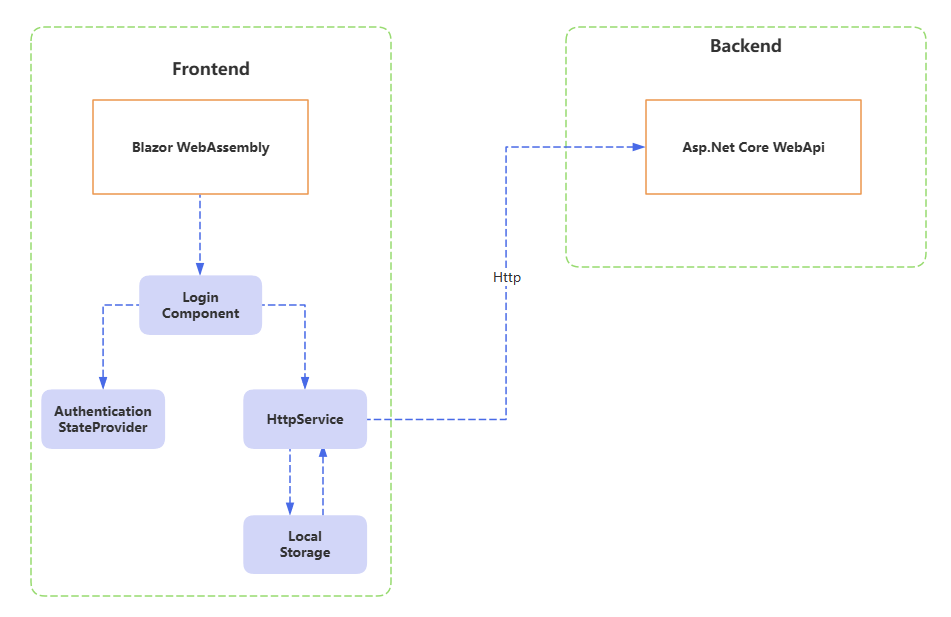 新增Nuget包
新增Nuget包
dotnet add package Blazored.LocalStorage --version 4.5.0
服务注册
builder.Services.AddBlazoredLocalStorage();
只需修改HttpService,当每次实例化时,从LocalStorage中拿到Token,当登录完成后,存储Token即可。
public class HttpService
{
private readonly HttpClient _httpClient;
private readonly ISyncLocalStorageService _localStorageService;
public HttpService(HttpClient httpClient, ISyncLocalStorageService localStorageService)
{
_httpClient = httpClient;
_localStorageService = localStorageService;
var token = _localStorageService.GetItem<string>("token");
if (token != null)
{
_httpClient.DefaultRequestHeaders.Authorization = new AuthenticationHeaderValue("Bearer", token);
}
}
public async Task<LoginResponse?> LoginAsync(LoginRequest loginRequest)
{
var response = await _httpClient.PostAsJsonAsync("api/account/login", loginRequest);
if (response.IsSuccessStatusCode)
{
var loginResponse = await response.Content.ReadFromJsonAsync<LoginResponse>();
_httpClient.DefaultRequestHeaders.Authorization = new AuthenticationHeaderValue("Bearer", loginResponse.Token);
_localStorageService.SetItem("token", loginResponse.Token);
return loginResponse!;
}
return null;
}
public async Task<string?> GetCurrentUserName()
{
var response = await _httpClient.GetAsync("api/account/CurrentUserName");
if (response.IsSuccessStatusCode)
{
var currentUserName = await response.Content.ReadAsStringAsync();
return currentUserName!;
}
return null;
}
}
客户端退出
退出无非是清理LocalStorage中的Token,附带要更新StateProvider当前状态。
在HttpService内,清理LocalStorage中的Token,与重置生命周期内HttpClient的头。
public async Task LogoutAsync()
{
_httpClient.DefaultRequestHeaders.Authorization = null;
_localStorageService.RemoveItem("token");
}
在StateProvider内,更新身份状态。
public async Task MarkUserAsUnauthenticated()
{
// 刷新身份状态
NotifyAuthenticationStateChanged(GetAuthenticationStateAsync());
}
最终点击Logout按钮触发事件内执行逻辑
private async Task Logout()
{
await _httpService.LogoutAsync();
await ((CustomAuthStateProvider)_authStateProvider).MarkUserAsUnauthenticated();
_navigationManager.NavigateTo("/Login");
}
客户端路由权限控制
当浏览器中直接敲入目标地址,如果当前未处于登录状态且目标地址为鉴权完成才能查看,则需要对目标地址进行保护。
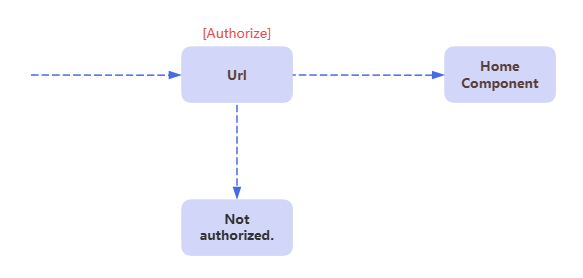 默认的路由设定为未鉴权也可以访问,需要替换为鉴权完毕才能访问,在App.razor中替换,RouteView为AuthorizeRouteView
默认的路由设定为未鉴权也可以访问,需要替换为鉴权完毕才能访问,在App.razor中替换,RouteView为AuthorizeRouteView
@using Microsoft.AspNetCore.Components.Authorization
<Router AppAssembly="@typeof(App).Assembly">
<Found Context="routeData">
<AuthorizeRouteView RouteData="@routeData" DefaultLayout="@typeof(MainLayout)" />
<FocusOnNavigate RouteData="@routeData" Selector="h1" />
</Found>
<NotFound>
<PageTitle>Not found</PageTitle>
<LayoutView Layout="@typeof(MainLayout)">
<p role="alert">Sorry, there's nothing at this address.</p>
</LayoutView>
</NotFound>
</Router>
当没有鉴权通过时,可以进行重定向跳转到登录页。新建一个重定向组件。示例如下。
@inject NavigationManager Navigation
@code {
protected override void OnInitialized()
{
Navigation.NavigateTo("/login");
}
}
应用到App.razor中便是根据身份状态判断,重定向到登录页或者提示没有访问权限。
<AuthorizeRouteView RouteData="@routeData" DefaultLayout="@typeof(MainLayout)">
<NotAuthorized>
@if (context.User.Identity?.IsAuthenticated != true)
{
<RedirectToLogin />
}
else
{
<p role="alert">You are not authorized to access this resource.</p>
}
</NotAuthorized>
</AuthorizeRouteView>
客户端获取身份状态
在之前的示例中是借助于AuthorizeView,其内部封装好了user。
<AuthorizeView>
<Authorized>
<p>Hello, @context.User.Identity?.Name!</p>
</Authorized>
<NotAuthorized>
<p>You're not authorized.</p>
</NotAuthorized>
</AuthorizeView>
但是如果想要手动获取状态从而判断是否鉴权与否。可以通过Task参数。这个依赖于服务注册时的builder.Service.AddCascadingAuthenticationState,其内部实现是实例化Task。
@code {
private string? _userName = "";
[CascadingParameter]
private Task<AuthenticationState>? authenticationState { get; set; }
private async Task DoSomething()
{
if (authenticationState is not null)
{
var authState = await authenticationState;
var user = authState?.User;
if (user is not null)
{
if (user.Identity is not null && user.Identity.IsAuthenticated)
{
_userName = user.Identity.Name;
}
}
}
}
}
可能会说是否可以直接注入AuthenticationStateProvider,可以但不建议,因为身份验证状态发生改变,不会自动通知组件。 https://learn.microsoft.com/zh-cn/aspnet/core/blazor/security/?view=aspnetcore-9.0&tabs=visual-studio#authenticationstateprovider-service
获取身份状态也就区分了使用场景,在Html中使用AuthorizeView,在Code中使用Task,这两个内部都是从AuthenticationStateProvider获取身份状态。
注意事项
Route上写是.Net8以前的用法,之后是采用服务注册builder.Service.AddCascadingAuthenticationState。很多文章视频中都是用的稀里糊涂。
默认场景下,Task是需要依赖于AddCascadingAuthenticationState。但在使用了AuthorizeRouteView后,发现无需注册AddCascadingAuthenticationState,也能够正常使用Task,
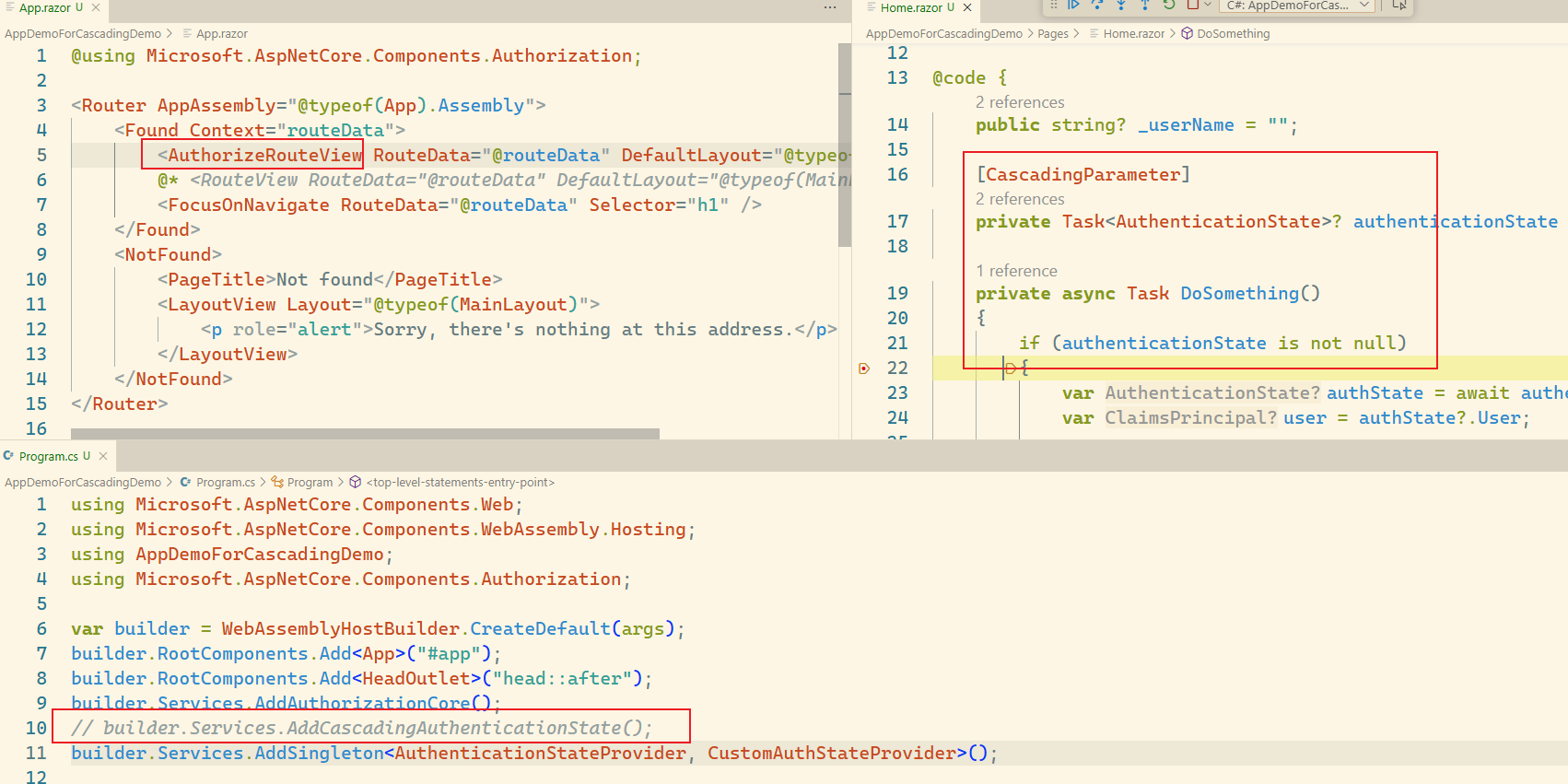 找到源码发现,AuthorizeRouteView中存在了一个判断逻辑,当没有时,会有一些处理逻辑。
找到源码发现,AuthorizeRouteView中存在了一个判断逻辑,当没有时,会有一些处理逻辑。
https://source.dot.net/#Microsoft.AspNetCore.Components.Authorization/AuthorizeRouteView.cs,70
参考文档
2025-07-08,望技术有成后能回来看见自己的脚步。